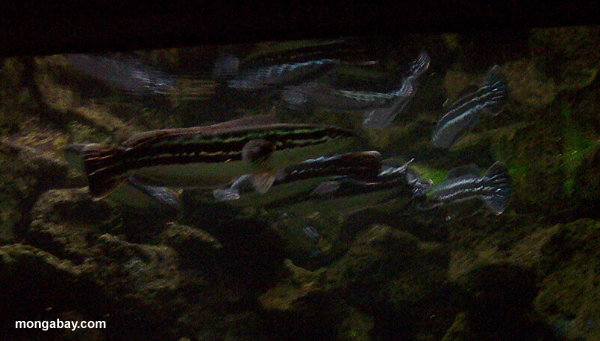OTHERS
CHANNIDAE FAMILY

|
The Channidae or Snake-head family includes large, piscivorous fish of Asia and Africa. Snakeheads possess an accessory organ for breathing atmospheric air in oxygen depleted bodies of water. These species are important food fishes in their native lands.
Green Snakehead
Channa orientalis
SYN: Channa gachua, Ophiocephalus kelaartii
PD: An elongated species with a fan-like caudal fin. The rear half of the fish is laterally compressed. The dorsal fin has a long base, running from above the base of the pectoral fins to the caudal peduncle. The anal fins also has a long base, although not as long as the dorsal. The head is rounded and the mouth is deeply cleft. The back is light brown to green-brown while the flanks range from brown-blue to blue-green. The throat is pale blue and the iris of the eye is orange. The base of the anal, caudal, and dorsal fins is green-brown, followed by a blue band and then a black band. The fins are bordered in yellow.
SIZE: To 12" (30 cm) although not usually more than 8" (20 cm)
SS: C. gachua can be found in slow-moving parts of the same rivers that C. orientalis inhabits. The physical difference between the two species is that C. gachua has ventral fins. This species also differs in its care of the brood. The eggs are mouthbrooded for 3-4 days, and number up to 300. C. gachua does not feed their young-unlike C. orientalis .
HAB: Fast-flowing, rainforest streams. Sri Lanka
S: bottom
TANK: A 32" (81 cm) or 30 gallon (114 L) tank is sufficient. The tank should have a cover of floating plants to diffuse the lighting, which should be dim. It should be well-planted and have many hiding places. Use a tight-fitting cover because these fish are excellent jumpers.
WATER: pH 6-7.5 (6.8), 4-20 dH (10), 75-82°F (24-28°C)
SB: Keep with other large-bodied, calm fish that do not participate in brood care. This fish eats other fish's fry in nature, and this habits may cause conflicts with "parenting" fish in an aquarium. The Green Snakehead is a loner, and is quite content without other fish. While young, fish form small schools. But with age, fish become less sociable and have a tendency of cannibalizing smaller or weaker fish. The Green Snakehead is easier to keep in a species tank. In a species tank, an individual may become friendly and even tame, taking food from the owner's hand.
SC: Loricarids, Pimelodids, Synodontis, Clariidae Catfish; Giant Danios, larger barbs, African tetras
FOOD: Live; small fish, worms, brine shrimp, insect larvae; chopped meat; possibly pellets
SEX: Females are plumper
B: The Green Snakehead is a difficult fish to breed because of its nature as a loner. Thus pairs rarely form. However, successful spawns have been recorded. The pair embraces much like labyrinth fish, during courtship. The eggs are released and the fertilized ones float to the surface where the male takes them into his mouth. He mouthbroods the eggs-not usually more than 50-for 9-10 days. Both parents guard the eggs and the fry. After the young are free-swimming, the female provides them with food. She swims rapidly in a circular motion, releasing sinking eggs. The fry feed on these eggs. These "food eggs" result from food reserves in the female's body. The female stops feeding the fry, the unfertilized eggs, when they reach 1.5" (4 cm).
BP: 9. Breeding the Green Snakehead is very difficult because of their solitary nature.
REMARKS: The Green Snakehead is sexually mature at 4" (10 cm). Often C. orientalis lives in parts of riverbeds that dry up during the summer months. Once the main channel is gone, this fish remains in puddles until these too dry up. Then C. orientalis is forced to move overland from one water hole to another by jumping and using its pectoral fins to move along.
DC: 5. A large, hardy fish that is easy to keep in a roomy species tank. Its diet must include live foods.